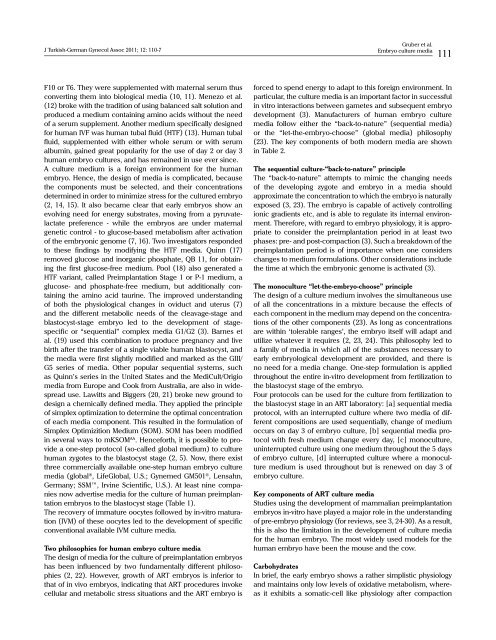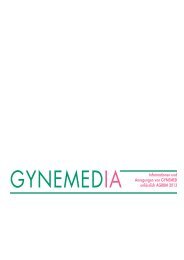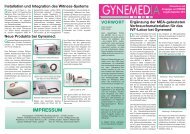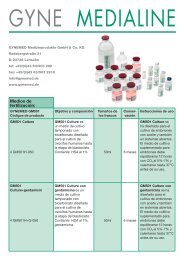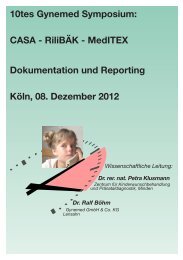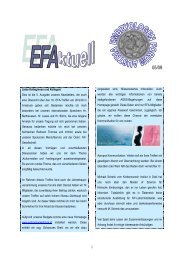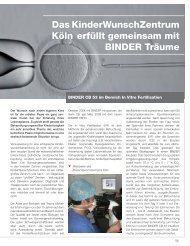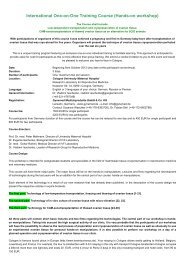Embryo culture media for human IVF: which ... - JournalAgent
Embryo culture media for human IVF: which ... - JournalAgent
Embryo culture media for human IVF: which ... - JournalAgent
You also want an ePaper? Increase the reach of your titles
YUMPU automatically turns print PDFs into web optimized ePapers that Google loves.
J Turkish-German Gynecol Assoc 2011; 12: 110-7<br />
F10 or T6. They were supplemented with maternal serum thus<br />
converting them into biological <strong>media</strong> (10, 11). Menezo et al.<br />
(12) broke with the tradition of using balanced salt solution and<br />
produced a medium containing amino acids without the need<br />
of a serum supplement. Another medium specifically designed<br />
<strong>for</strong> <strong>human</strong> <strong>IVF</strong> was <strong>human</strong> tubal fluid (HTF) (13). Human tubal<br />
fluid, supplemented with either whole serum or with serum<br />
albumin, gained great popularity <strong>for</strong> the use of day 2 or day 3<br />
<strong>human</strong> embryo <strong>culture</strong>s, and has remained in use ever since.<br />
A <strong>culture</strong> medium is a <strong>for</strong>eign environment <strong>for</strong> the <strong>human</strong><br />
embryo. Hence, the design of <strong>media</strong> is complicated, because<br />
the components must be selected, and their concentrations<br />
determined in order to minimize stress <strong>for</strong> the <strong>culture</strong>d embryo<br />
(2, 14, 15). It also became clear that early embryos show an<br />
evolving need <strong>for</strong> energy substrates, moving from a pyruvatelactate<br />
preference - while the embryos are under maternal<br />
genetic control - to glucose-based metabolism after activation<br />
of the embryonic genome (7, 16). Two investigators responded<br />
to these findings by modifying the HTF <strong>media</strong>. Quinn (17)<br />
removed glucose and inorganic phosphate, QB 11, <strong>for</strong> obtaining<br />
the first glucose-free medium. Pool (18) also generated a<br />
HTF variant, called Preimplantation Stage 1 or P-1 medium, a<br />
glucose- and phosphate-free medium, but additionally containing<br />
the amino acid taurine. The improved understanding<br />
of both the physiological changes in oviduct and uterus (7)<br />
and the different metabolic needs of the cleavage-stage and<br />
blastocyst-stage embryo led to the development of stagespecific<br />
or “sequential” complex <strong>media</strong> G1/G2 (3). Barnes et<br />
al. (19) used this combination to produce pregnancy and live<br />
birth after the transfer of a single viable <strong>human</strong> blastocyst, and<br />
the <strong>media</strong> were first slightly modified and marked as the GIII/<br />
G5 series of <strong>media</strong>. Other popular sequential systems, such<br />
as Quinn’s series in the United States and the MediCult/Origio<br />
<strong>media</strong> from Europe and Cook from Australia, are also in widespread<br />
use. Lawitts and Biggers (20, 21) broke new ground to<br />
design a chemically defined <strong>media</strong>. They applied the principle<br />
of simplex optimization to determine the optimal concentration<br />
of each <strong>media</strong> component. This resulted in the <strong>for</strong>mulation of<br />
Simplex Optimizition Medium (SOM). SOM has been modified<br />
in several ways to mKSOM AA . Hence<strong>for</strong>th, it is possible to provide<br />
a one-step protocol (so-called global medium) to <strong>culture</strong><br />
<strong>human</strong> zygotes to the blastocyst stage (2, 5). Now, there exist<br />
three commercially available one-step <strong>human</strong> embryo <strong>culture</strong><br />
<strong>media</strong> (global ® , LifeGlobal, U.S.; Gynemed GM501 ® , Lensahn,<br />
Germany; SSM, Irvine Scientific, U.S.). At least nine companies<br />
now advertise <strong>media</strong> <strong>for</strong> the <strong>culture</strong> of <strong>human</strong> preimplantation<br />
embryos to the blastocyst stage (Table 1).<br />
The recovery of immature oocytes followed by in-vitro maturation<br />
(IVM) of these oocytes led to the development of specific<br />
conventional available IVM <strong>culture</strong> <strong>media</strong>.<br />
Two philosophies <strong>for</strong> <strong>human</strong> embryo <strong>culture</strong> <strong>media</strong><br />
The design of <strong>media</strong> <strong>for</strong> the <strong>culture</strong> of preimplantation embryos<br />
has been influenced by two fundamentally different philosophies<br />
(2, 22). However, growth of ART embryos is inferior to<br />
that of in vivo embryos, indicating that ART procedures invoke<br />
cellular and metabolic stress situations and the ART embryo is<br />
Gruber et al.<br />
<strong>Embryo</strong> <strong>culture</strong> <strong>media</strong> 111<br />
<strong>for</strong>ced to spend energy to adapt to this <strong>for</strong>eign environment. In<br />
particular, the <strong>culture</strong> <strong>media</strong> is an important factor in successful<br />
in vitro interactions between gametes and subsequent embryo<br />
development (3). Manufacturers of <strong>human</strong> embryo <strong>culture</strong><br />
<strong>media</strong> follow either the “back-to-nature” (sequential <strong>media</strong>)<br />
or the “let-the-embryo-choose” (global <strong>media</strong>) philosophy<br />
(23). The key components of both modern <strong>media</strong> are shown<br />
in Table 2.<br />
The sequential <strong>culture</strong>-“back-to-nature” principle<br />
The “back-to-nature” attempts to mimic the changing needs<br />
of the developing zygote and embryo in a <strong>media</strong> should<br />
approximate the concentration to <strong>which</strong> the embryo is naturally<br />
exposed (3, 23). The embryo is capable of actively controlling<br />
ionic gradients etc, and is able to regulate its internal environment.<br />
There<strong>for</strong>e, with regard to embryo physiology, it is appropriate<br />
to consider the preimplantation period in at least two<br />
phases: pre- and post-compaction (3). Such a breakdown of the<br />
preimplantation period is of importance when one considers<br />
changes to medium <strong>for</strong>mulations. Other considerations include<br />
the time at <strong>which</strong> the embryonic genome is activated (3).<br />
The mono<strong>culture</strong> “let-the-embryo-choose” principle<br />
The design of a <strong>culture</strong> medium involves the simultaneous use<br />
of all the concentrations in a mixture because the effects of<br />
each component in the medium may depend on the concentrations<br />
of the other components (23). As long as concentrations<br />
are within ‘tolerable ranges’, the embryo itself will adapt and<br />
utilize whatever it requires (2, 23, 24). This philosophy led to<br />
a family of <strong>media</strong> in <strong>which</strong> all of the substances necessary to<br />
early embryological development are provided, and there is<br />
no need <strong>for</strong> a <strong>media</strong> change. One-step <strong>for</strong>mulation is applied<br />
throughout the entire in-vitro development from fertilization to<br />
the blastocyst stage of the embryo.<br />
Four protocols can be used <strong>for</strong> the <strong>culture</strong> from fertilization to<br />
the blastocyst stage in an ART laboratory: [a] sequential <strong>media</strong><br />
protocol, with an interrupted <strong>culture</strong> where two <strong>media</strong> of different<br />
compositions are used sequentially, change of medium<br />
occurs on day 3 of embryo <strong>culture</strong>, [b] sequential <strong>media</strong> protocol<br />
with fresh medium change every day, [c] mono<strong>culture</strong>,<br />
uninterrupted <strong>culture</strong> using one medium throughout the 5 days<br />
of embryo <strong>culture</strong>, [d] interrupted <strong>culture</strong> where a mono<strong>culture</strong><br />
medium is used throughout but is renewed on day 3 of<br />
embryo <strong>culture</strong>.<br />
Key components of ART <strong>culture</strong> <strong>media</strong><br />
Studies using the development of mammalian preimplantation<br />
embryos in-vitro have played a major role in the understanding<br />
of pre-embryo physiology (<strong>for</strong> reviews, see 3, 24-30). As a result,<br />
this is also the limitation in the development of <strong>culture</strong> <strong>media</strong><br />
<strong>for</strong> the <strong>human</strong> embryo. The most widely used models <strong>for</strong> the<br />
<strong>human</strong> embryo have been the mouse and the cow.<br />
Carbohydrates<br />
In brief, the early embryo shows a rather simplistic physiology<br />
and maintains only low levels of oxidative metabolism, whereas<br />
it exhibits a somatic-cell like physiology after compaction


